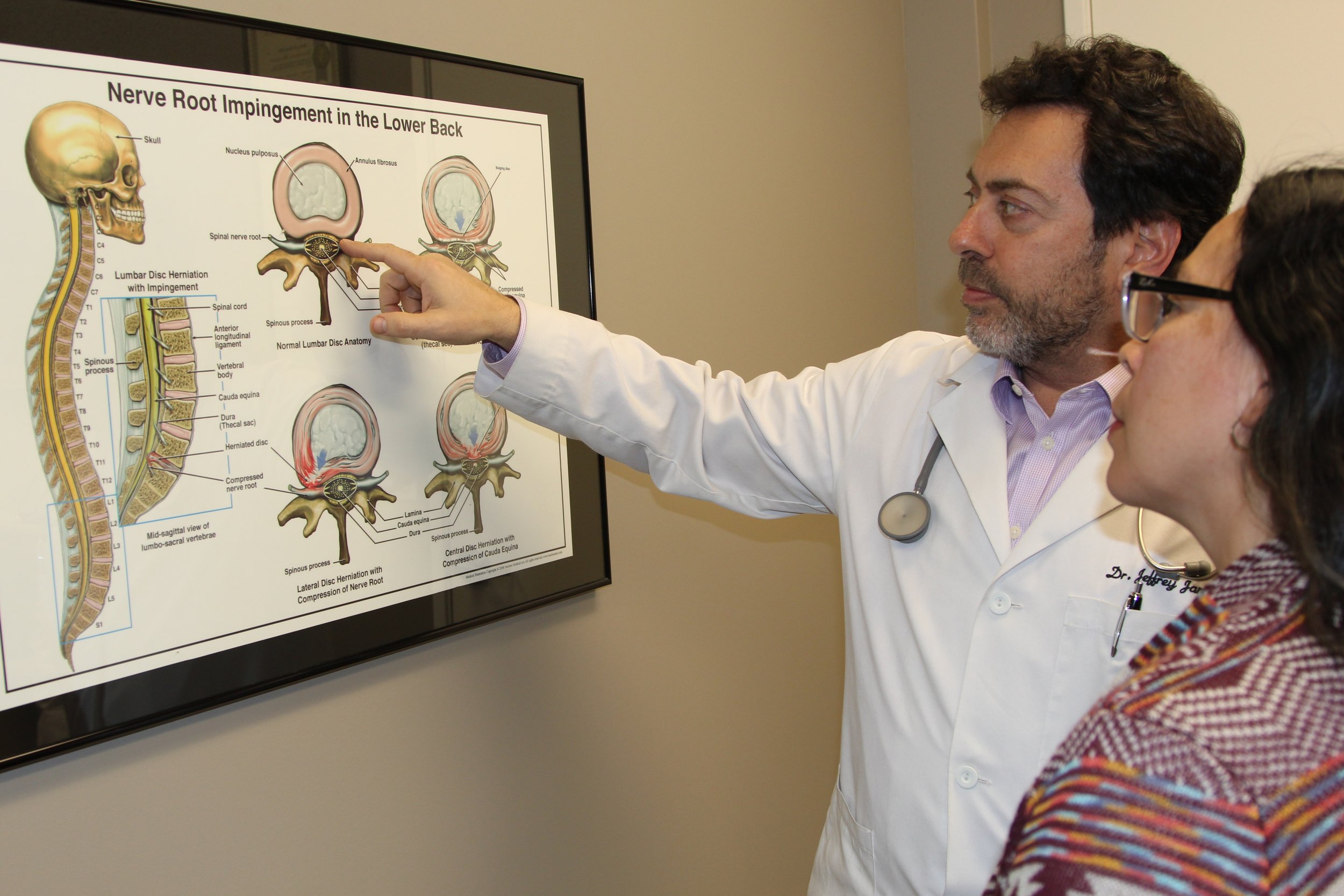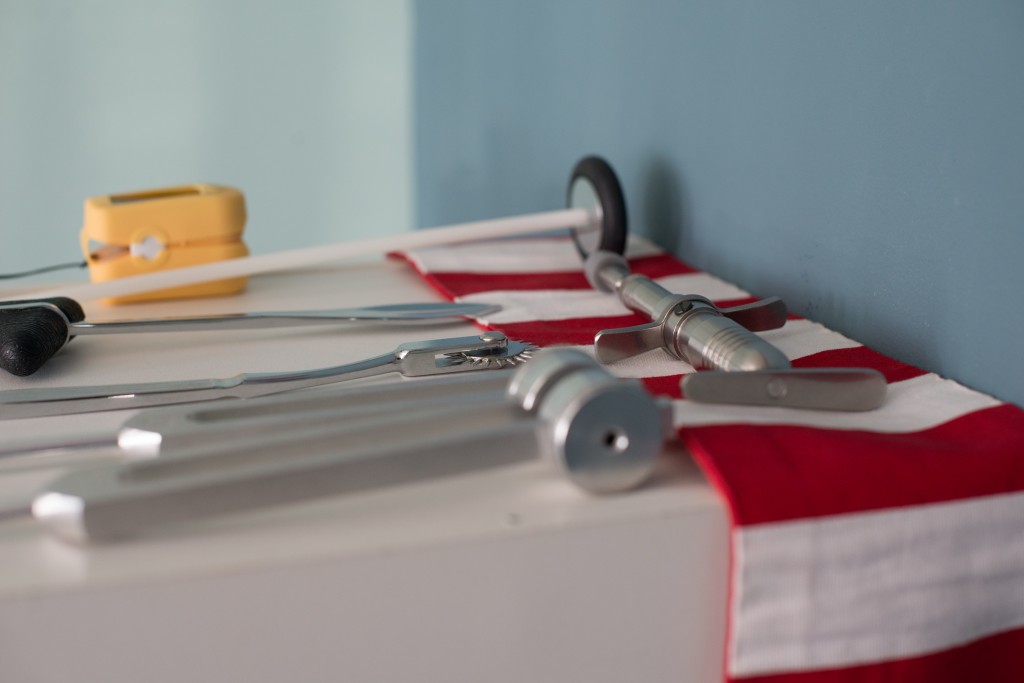Herniated Nucleus Pulposus (HNP)
Your intervertebral disc is the structure that sits between the vertebrae in your spine to absorb the shock of your body in gravity and to resist gravity, and to give flexibility to your spine. You have discs from C2 all the way down to your sacrum, the triangular bone that sits at the bottom of your spine and connects to your two ilium bones.
The disc can be thought of as a jelly donut. It has a soft gel-like center that is contained by a tough outer band of ligaments called the annulus fibrosis that run at cross angles to one another. The center of the disc is called the nucleus pulposus. The nucleus pulposus is made up of this crazy substance called proteoaminoglycosaminoglycans — it’s ok if you can’t pronounce it! Basically, it’s a gel like structure that helps the vertebrae rotate and pivot and distribute weight and forces applied to it.
The term cervical herniated disc, thoracic herniated disc, or lumbar herniated disc all refer to the same problem; they are simply differentiated by region in the spine. Cervical refers to neck, thoracic herniated disc refers to the middle of your back where your ribs attach, and lumbar herniated disc refers to your low back.
When you read or hear the term herniated nucleus pulposus, it means that the gel-like substance has pushed the annulus fibrosis out, or it has pushed through the annulus, which is generally called a ruptured disc. Imagine pressing your hand down on a jelly donut, and watch the jelly leak out the side — this is what it looks like.
Types of
Disc herniations
In general, there are three - four types or classifications of disc herniations.
Disc Protrusions
This is where the herniation simply protrudes straight out of the disc. The most common place for this to occur is in the posterolateral position, that means to the back and outside portion of the disc, the reason this happens is that there is a ligament called the posterior longitudinal ligament that runs along the back of the spine inside the spinal canal, and generally acts as guard against the disc herniating straight back, although herniated discs can and do push that ligament back and herniate into the spinal canal.
Disc Extrusions
A disc extrusion means that the protruded part of the disc took a turn. The material might drop behind the disc and migrate down like candle wax dripping down a candle, or it might take a right or left turn and the disc material might migrate to the side, or the herniated disc material can move superiorly or upward behind this disc defying gravity!
Disc Sequestration
This generally means that if you had a disc protrusion or extrusion, a piece of the disc has broken off, and you now have a fragment that might be loosely attached to the original herniation. Or, it might be what we call a free floating fragment. This is usually called a sequestered fragment by radiologists, but all radiologist use these terms somewhat loosely. So, when in question, it’s always best to confirm with the radiologist exactly what he means.
Ruptured Discs
This usually means that the nucleus of the disc whether protruded or extruded has gone beyond the bounds of the annulus fibrosis, and has ruptured the annulus fibers, ergo “ruptured disc”.
Symptoms
Symptoms of a herniated nucleus pulposus as with any disc herniation can range from no pain to severe pain and radiation of pain into the extremities, or up and down your back. However, The pain you can experience is often related to the type of herniation that you have. You can have back or neck pain, sciatica, pain in one or both legs, or arms, shooting pains, dull aching pains, numbness, tingling weakness. If you have a disc herniation in your neck, then pain could be experienced in your arms or upper back, and if you have an extrusion in your lower back, then you might experience pain or numbness and tingling in your back and into your legs.
Causes
Disc herniations can be caused by anything that could weaken the spine and discs, such as:
a slip and fall
an auto accident
or any other trauma.
A disc herniation can also be caused by a sedentary lifestyle or lack of movement, which leads to the disc drying out and weakening. Then, you make a move that you have a hundred times before, like:
reaching into your back seat of your car to grab something, and your gripped by paralyzing pain,
or you bend over to pick up a pencil, and experience excruciating pain.
treatments
One of the most effective means of treating a herniated nucleus pulposus is Non-Surgical Spinal Decompression. Non-surgical spinal decompression allows us to reduce the compressive force on the disc, allowing us to reduce the disc herniation size and restore normal function to the disc. This can then remove the pressure on pinched nerves caused by the disc herniation, reducing and eliminating the pain caused by them. In addition, we do many other therapies designed to improve strength and mobility to your spine, hips, and neck to reduce the likelihood of re-injury.
In some cases, when we are unable to help a patient with a large disc herniation, surgery may be required. Non-invasive, non-surgical decompression should always be tried before surgery, after a proper neurological examination has been performed to determine if you are a good candidate for this procedure.





